| Article ID | Journal | Published Year | Pages | File Type |
|---|---|---|---|---|
| 641063 | Separation and Purification Technology | 2014 | 8 Pages |
•Selective flocculation for enrichment of ultrafine chromite.•Study was carried out using synthetic mixture of high grade chromite and kaolin.•Degraded wheat starch was used as flocculant.•Box–Behnken experimental design was applied to study the effect of parameters.•Optimization of the parameters were performed.
Chromite tailings are generated from chrome ore beneficiation plants, containing substantial quantities of ultrafine particles. Generally these ultrafine particles of chromite cannot be treated effectively using conventional beneficiation methods, because of limitations in particles size being treated by these processes. Selective flocculation process could be one of the alternative physico-chemical methods for treating these ultrafine particles. Here an attempt was taken to establish selective flocculation process for treating chromite particles using synthetic mixture of high grade chromite ore and kaolin. Box Behnken experimental design was applied to study the significance of operating parameters like flocculant dose, dispersant dose and pH on responses of selective flocculation process. Both pH and flocculant dose significantly affect selective flocculation process. Further, an optimization of process parameters were also carried out and optimized response was found to be 41.86% grade of Cr2O3 in concentrate with 69.73% recovery.
Graphical abstract3D response surface plot for effect of pH and flocculant dose on grade of concentrate.Figure optionsDownload full-size imageDownload as PowerPoint slide
